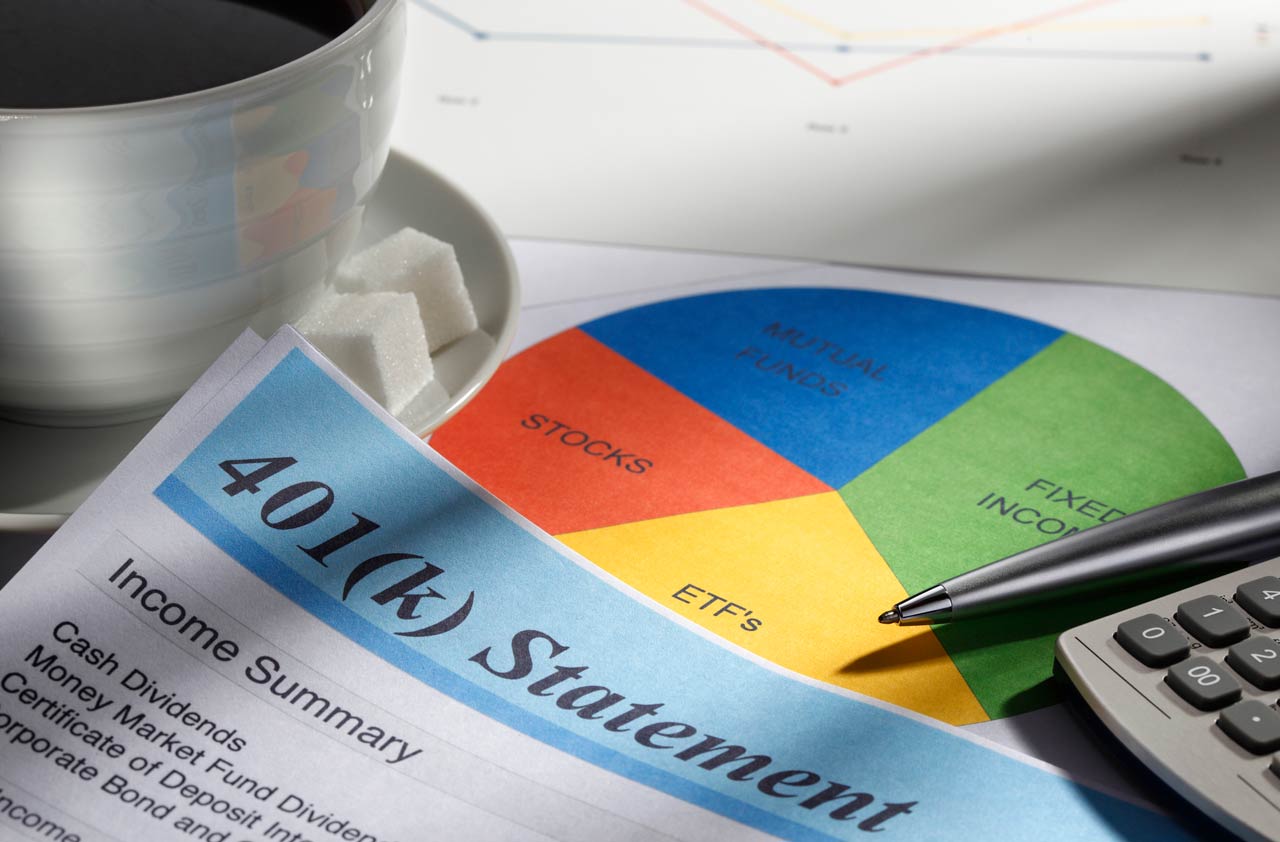Building a Better 401(k)
Funneling all your retirement contributions into a target-date fund isn’t always the best strategy.


In this era of do-it-yourself retirement planning, your quality of life in retirement will probably depend on how much you’ve stashed in your 401(k) or similar employer-sponsored retirement plan. Fortunately, a raft of plan enhancements, ranging from automatic enrollment to set-it-and-forget-it portfolios, have reduced the risk that you’ll misuse this valuable asset. But that doesn’t mean you can’t do more to get the most from your plan.
Hands down, the most effective way to increase your plan’s performance is to divert as much as you can from your paycheck. Your savings will grow even faster if your employer offers a company match—on average, employers match 4.7% of pay—which is why it’s critical to contribute at least enough to pocket that free money.
But once you’ve established a savings routine, you have to figure out how to invest the money. One option that’s increasingly popular with 401(k) plan participants is a target-date fund. With these funds, you select a year that’s closest to the year you think you’ll retire and let someone else manage your mix of stocks and bonds. As you get closer to retirement, your allocation of stocks and bonds will gradually become more conservative. Half of 401(k) plan participants invest at least some of their money in target-date funds, according to the Investment Company Institute.

Sign up for Kiplinger’s Free E-Newsletters
Profit and prosper with the best of expert advice on investing, taxes, retirement, personal finance and more - straight to your e-mail.
Profit and prosper with the best of expert advice - straight to your e-mail.
Jonathan Leung, 25, a software engineer for Amazon, opted for a target-date fund when he signed up for the company’s 401(k) plan in 2017. The fund invests 90% of his savings in stock funds and 10% in bond funds. Vanguard, which administers his plan, offered other options, but “I wanted my plan to be on autopilot,” he says. Leung initially contributed 4% of his paycheck in order to qualify for the maximum company match, which is half of contributions up to 4%; after he got a raise, he increased his contribution to 15%.
For young workers like Leung, a target-date fund makes sense, financial planners say. The fund invests most of his savings in stocks, which is appropriate for someone who’s still many years from retirement, and it will automatically rebalance to maintain its target allocation.
Another argument for using a target-date fund, even if you’re in your thirties or forties, is that it will prevent you from making moves you’ll regret later. Investors who manage their own investments are often tempted to bail during downturns, which can torpedo long-term returns. “The more people trade, the worse their returns are,” says Jamie Hopkins, director of retirement research for Carson Wealth, a wealth management firm.
Create your own portfolio?
That said, if your 401(k) offers a good mix of low-cost investments and you’re willing to do some research (or work with a financial adviser), you may get better returns by creating your own portfolio. And even if you decide you’d rather follow a set-it-and-forget-it strategy, you may want to reassess your target-date portfolio as you approach retirement.
A typical target-date fund has what’s known as a glide path, which represents the shift in the fund’s allocation of stocks, bonds and other investments over time. But that’s where this one-size-fits-all strategy runs into trouble, because it may not take into account when you actually retire, says Ashley Coake, a certified financial planner with Cultivate Financial Planning, in Radford, Va. Some target-date funds keep shifting their mix decades past the target year; others stop at the target year.
Suppose you’re 60 and decide you want to retire earlier than you had planned—say, in a couple of years—but you’re invested in a fund with a target date of 2030. You’ll need to review your investment with an eye toward the earlier retirement date. For instance, you may want to consider shifting some or all of your assets slowly from the 2030 fund into a 2020 or 2025 target date fund, which would be more conservatively positioned. Otherwise, depending on the 2030 fund, you could still have a significant percentage of your savings in stocks. If the market heads into bear territory in the next year or two, you may not have enough time to recover your losses before you start taking withdrawals. Those losses could be exacerbated if the fund automatically rebalances and sells stocks during the downturn, says Andy Mardock, a CFP with ViviFi Planning, in Bend, Ore.
Some older workers could end up with the opposite problem: a too-conservative asset mix. “Even at retirement, people are going to live another 20 to 30 years,” says Tracie McMillion, head of global asset allocation strategy for Wells Fargo Investment Institute. “They still need growth assets to continue to grow the pool from which they can draw income and keep up with inflation,” she says.
If you’re in your fifties and have your 401(k) invested in a target-date fund, you may want to move your savings into a combination of stock and bond funds that more closely aligns with your goals, Mardock says. Your retirement plan may provide tools that will help you determine how much you’ll need to earn from your investments to support your retirement lifestyle. Or you can sit down with a financial planner to design a plan that works for you. Some 401(k) providers offer a free consultation with a certified financial planner.
On the other hand, if you’re decades from retirement, you may want a more aggressive mix of stocks and bonds than your plan’s target-date fund delivers. One option is to keep your target-date fund as your core holding and add a fund or two from your 401(k) plan’s roster that will increase your stock allocation. This strategy also provides a way to add assets that aren’t included in your target-date portfolio, such as funds that invest in real estate, commodities or emerging markets.
You can also design your own portfolio, using, say, an index fund that tracks Standard & Poor’s 500-stock index as a core holding, accounting for anywhere from 40% to 60% of your portfolio, and fleshing out the rest with international holdings, fixed-income investments and whatever tactical investments fit with your tolerance for risk.
If you decide to manage your own portfolio, you need to rebalance at least once a year to make sure your mix of stocks and bonds doesn’t stray from your goals. Otherwise, your portfolio could become riskier—or more conservative, depending on how the market has performed—than you intended. Many 401(k) plans will automatically rebalance your plan at specific intervals, such as quarterly or annually.
Tap the power of a Roth
Money invested in traditional 401(k) plans is tax-deferred, which means you’ll have to pay federal taxes on the money when you take it out. Depending on where you live, your state may take a chunk of your savings, too.
That’s why many financial planners recommend diverting at least a portion of your savings to a Roth 401(k) plan if your employer offers that option (about 70% of employer-provided plans do). Money invested in a Roth 401(k) is after-tax but, as is the case with regular Roth IRAs, withdrawals are tax- and penalty-free as long as you’ve owned the account for at least five years and are 59½ or older when you withdraw the money.
Roth 401(k)s are a particularly powerful tool for young workers because they’re in a position to reap many years of tax-free growth. It’s also a smart strategy for savers who think they’ll be in a higher tax bracket when they retire, Mardock says.
Even if you’re farther along in your career, diversifying some of your contributions to a Roth 401(k) will give you more flexibility when you retire. As long as you roll your money into a Roth IRA, you’ll have a pool of tax-free money that isn’t subject to required minimum distributions at age 70½, which is the case for IRAs and regular 401(k) plans. And unlike regular Roths, Roth 401(k)s have no income-eligibility limits.
If you like the idea of a tax-free account but also want the tax deduction a traditional 401(k) provides, funnel some money to a Roth 401(k) and put the rest in a tax-deferred 401(k) plan. The maximum you can contribute to both plans in 2019 is $19,000, or $25,000 if you’re 50 or older.
Think twice about annuities in your plan
The average large 401(k) plan offers 27 investment options, including stock funds, bond funds and target-date funds, according to a survey by the Investment Company Institute and BrightScope. Soon you may see another option on the menu: annuities.
Congress is considering legislation that would make it easier for 401(k) plans to offer equity-index, variable and other types of annuities. The provision is included in the SECURE Act (Setting Every Community Up for Retirement Enhancement), which passed the House in May and is pending in the Senate (see New Law Could Change Rules for IRA Withdrawals).
By law, 401(k) plans can offer annuities, but only about 10% of them do, in part because employers are afraid they could be sued if the insurance company behind the annuity fails to pay claims. (Annuities are more common in 403(b) plans, typically offered to teachers and nonprofit workers.) The legislation would protect employers from such lawsuits as long as they meet specific conditions.
Proponents of the measure—primarily insurance companies—say it would give employees an investment option that would convert to a stream of income once they retire, similar to the type of payments retirees receive from a traditional pension.
The legislation would also make annuities inside 401(k) plans portable, so workers who leave their jobs could roll them into another plan or IRA without incurring surrender charges and other fees.
Pros and cons. Annuities help address anxiety over income security, but many planners question whether an annuity is an appropriate investment for most 401(k) participants. Some annuities come with high fees—which the legislation doesn’t address—that will weigh down your returns. “It could be a very expensive way to invest inside your 401(k),” says Jamie Hopkins, director of retirement research for Carson Wealth, a wealth management firm. That could change if major providers decide to add annuities to the 401(k) plans they administer and put pressure on costs, Hopkins says. BlackRock, which has $6.5 trillion in assets under management, is considering adding annuities to the 401(k) plans it manages.
If the idea of a regular paycheck in retirement appeals to you, there are other ways to accomplish that goal. After you retire, you can use a portion of your savings to buy an immediate annuity. With these annuities, you give an insurance company a lump sum in exchange for a monthly paycheck for a specific period or the rest of your life. A less-expensive option is a deferred-income annuity, which provides a guaranteed source of income once you reach a certain age. For example, a 65-year-old could purchase an annuity that starts making payouts at age 80. An insurance broker can help you shop for the best deal, or you can compare payouts at online brokerage sites such as immediateannuities.com.
Fees matter
Even half a percentage point in investing fees can cost you thousands of dollars over your lifetime. Target-date funds are typically structured as “funds of funds,” which means you’ll usually pay the cost of the underlying funds along with an additional management fee. Thanks to competition, though, fees for target-date funds have come down.
The average expense ratio for target-date funds fell to 0.62% in 2018 from 0.66% in 2017, according to Morningstar, which attributed the decline to growing demand for low-cost investment options. Vanguard, which has a long history of low-cost investments, has come to dominate the target-date market, with nearly 40% of market share. Fidelity Investments has also helped push down costs, recently slashing fees on its most popular target-date funds by 14%. To get the complete picture, look for a line labeled “Acquired Fund Fees and Expenses,” which will show you the combined expense ratio of the target-date fund and the underlying funds.

When Jonathan Leung signed up for his company's 401(k) he chose a target-date fund, which makes sense for young workers. Photograph by Brooke Fitts
Get Kiplinger Today newsletter — free
Profit and prosper with the best of Kiplinger's advice on investing, taxes, retirement, personal finance and much more. Delivered daily. Enter your email in the box and click Sign Me Up.

Block joined Kiplinger in June 2012 from USA Today, where she was a reporter and personal finance columnist for more than 15 years. Prior to that, she worked for the Akron Beacon-Journal and Dow Jones Newswires. In 1993, she was a Knight-Bagehot fellow in economics and business journalism at the Columbia University Graduate School of Journalism. She has a BA in communications from Bethany College in Bethany, W.Va.
-
 Which Generation Pays the Most Taxes in the US?
Which Generation Pays the Most Taxes in the US?Tax Burden Polls show that most people feel like taxes are unfair. But which age group bears the brunt of the tax burden in the United States?
By Kelley R. Taylor
-
 How Much Will Car Prices Go Up With Tariffs?
How Much Will Car Prices Go Up With Tariffs?Tariffs could drive car prices up even higher, for new and used cars, as well as for American brands.
By Jim Patterson
-
 457 Plan Contribution Limits for 2025
457 Plan Contribution Limits for 2025Retirement plans There are higher 457 plan contribution limits for state and local government workers in 2025. That's good news for state and local government employees.
By Kathryn Pomroy
-
 Medicare Basics: 11 Things You Need to Know
Medicare Basics: 11 Things You Need to KnowMedicare There's Medicare Part A, Part B, Part D, Medigap plans, Medicare Advantage plans and so on. We sort out the confusion about signing up for Medicare — and much more.
By Catherine Siskos
-
 The Seven Worst Assets to Leave Your Kids or Grandkids
The Seven Worst Assets to Leave Your Kids or Grandkidsinheritance Leaving these assets to your loved ones may be more trouble than it’s worth. Here's how to avoid adding to their grief after you're gone.
By David Rodeck
-
 SEP IRA Contribution Limits for 2025
SEP IRA Contribution Limits for 2025SEP IRA A good option for small business owners, SEP IRAs allow individual annual contributions of as much as $70,000 in 2025, up from $69,000 in 2024.
By Jackie Stewart
-
 Roth IRA Contribution Limits for 2025
Roth IRA Contribution Limits for 2025Roth IRAs Roth IRA contribution limits have gone up. Here's what you need to know.
By Jackie Stewart
-
 SIMPLE IRA Contribution Limits for 2025
SIMPLE IRA Contribution Limits for 2025simple IRA The SIMPLE IRA contribution limit increased by $500 for 2025. Workers at small businesses can contribute up to $16,500 or $20,000 if 50 or over and $21,750 if 60-63.
By Jackie Stewart
-
 457 Contribution Limits for 2024
457 Contribution Limits for 2024retirement plans State and local government workers can contribute more to their 457 plans in 2024 than in 2023.
By Jackie Stewart
-
 Roth 401(k) Contribution Limits for 2025
Roth 401(k) Contribution Limits for 2025retirement plans The Roth 401(k) contribution limit for 2025 increased, and workers who are 50 and older can save even more.
By Jackie Stewart